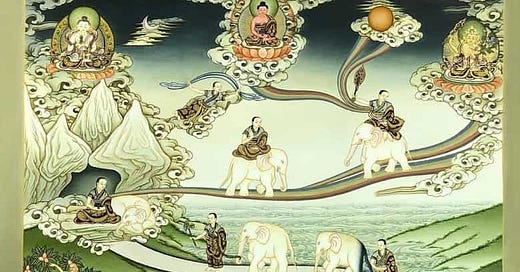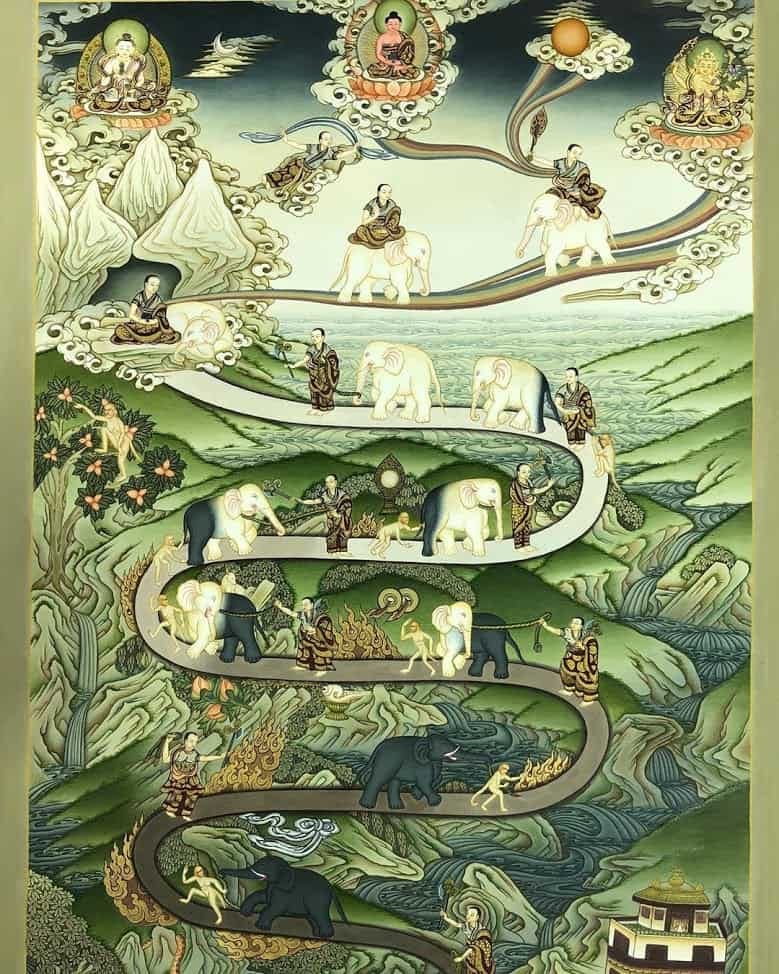The Elephant and the Rider. Most of us believe that we are in control of our lives, actions, thoughts and emotions. I've previously spoken about how this is an illusion, and today I'm going to use an ancient Tibetan thankgka as the illustration for a story. I'm naming the story "The Elephant and the Rider", a phrase I borrowed from a book on psychology named The Righteous Mind.
In that book they use a lot of evidence to discuss how all our decisions come from our deep subconscious (the Elephant), and us (the Rider), only think that we're in control of where the elephant goes. In their model the Rider is constantly telling a story about where they are going, after the Elephant has already made the decision. They are definitely going in the right direction, however they gloss over the finer point of "who we really are" in their model. They equate the sense of self, with the Rider, rather than the Observer.
In the Buddhist model, there are initially 3 layers. In the image above (I highly recommend downloading it and looking at it alongside this article, to see the FULL image you need to click on it), YOU are the Monk. The Monk is the observer, awareness. The Elephant is your subconscious, and the monkey is the discursive mind, the narrator, problem solver. That little voice in your head. Distractions. This particular painting represents the 9 stages of Samatha, or Concentration Meditation, plus a couple stages of Insight and beyond (the rainbow path).
Stage 1: Monkey Mind (Novice)
The Elephant and the Rider. Monkey Mind
In this stage the monkey is firmly in control. The Monk is so far in the background that the monkey and elephant are not even aware of his existence. They are just off running rampant, according to their desires, hopes, dreams, and fears. This is the state of existence for most people, and in fact, the Elephant is all Black because he is firmly in the shadows. So the sense of self rests firmly with the monkey, and he thinks he's in charge, even though it's the elephant that is running the show.
Stage 2: Starting to Catch Up (Novice)
Starting to Catch Up
After a stable daily meditative practice has been established, the monkey mind begins to calm, a bit. The elephant also calms down, and this gives awareness a chance to "catch up". In reality, it ends up being more about opportunities for awareness to shine through the noise of the monkey mind. The relationship with the monkey and the elephant is still very strong, as represented by the monkey still holding the tether. Reality still seems very real, and problems seem big, as represented by the fire on the path. The monkey still interrupts meditative focus very often. This stage represents the last stage of being a Novice meditator.
Stage 3: Seeing through the Monkey (Skilled)
Seeing thorugh the monkey
After some months or more, awareness has been able to shine through enough, that the elephant sees the value in the practice. He is now aware of awareness, and the value of the monk is shining through. This is represented by the elephant looking back at the monk, and the monk now holding the tether. You are now a Skilled meditator!
Purification of the deep mind has begun, which is represented by the elephant starting to turn white. The monkey is still going on about his business, acting like he's leading the pack, even though his perception of control is starting to wear thin. This is when the gaps between thoughts start to get bigger, and happen more often. You can now maintain continuous attention on your meditation object, but still deal with larger distractions, and tiredness.
Stage 4: Continued Purification (Skilled)
The Elephant and the Rider
In Stage 4, purification continues, and the relationship between the elephant and the rider, or monk, gets closer. In this stage, there is a subtle dullness to deal with, which feels very nice and kind of 'woozy' or trance-like, but is a trap. Meditation is meant to be focused and sharp, if you are here, watch out!
Stage 5: Awareness Front and Center (Skilled)
The Elephant and the Rider
The real you is starting to shine through. Awareness is now out front, leading the elephant. The Elephant is starting to look pretty happy, too. Now, the monkey mind is in the back, where he belongs. Following the elephant. Meditation is now regular, and easy. The monkey still gets "chatty" once in a while, but now quiets down very quickly under the eyes of awareness.
Stage 6: Awareness is Focused (Transitional)
The Elephant and the Rider
Now awareness is no longer distracted by thoughts (the monkey), or even emotions (the elephant). Awareness can shine through the focus of a mind skilled at meditation. This is represented by the monk no longer looking back towards the elephant and the monkey. The purification of mind continues, and as you can see the elephant is almost completely 'illuminated'.
Stage 7: Final Pacification (Adept)
The Elephant and the Rider
The sense of self here is no longer with the monkey, but the elephant. However, the instructions for this stage correct that misunderstanding. Here the meditator is told to "let go" of control, of focus. I wrote an article on this stage of practice as well. This is represented by the monk standing behind the elephant with his hands folded. He is allowing the elephant to go about his business. And guess what! Focus is lost, then regained...all without the monk doing anything. Tremendous realization happens here. You observe that the elephant can be trained, and it's also responsible for all 'action'. You are the watcher (the monk), but you can also "train the dog" (the elephant). In this moment...the sense of self shifts from the elephant (body / mind) to awareness. This is the final purification.
Stage 8: Seeing Through Ego (Adept)
The Elephant and the Rider
Now, the monkey is gone. The monk is out front again, and the elephant is happy to follow, as he's been completely purified. In this stage, practice is automatic, there is no pushing or trying. Over time meditative joy that has arisen will calm down, and then you will move into the next stage.
Stage 9: Tranquility and Equanimity (Adept)
The Elephant and the Rider
Now the monk and the elephant both rest in perfect absorption. They rest together in a state of 'not knowing' (no monkey) and 'not acting' (they are sitting). This is the final stage of Samatha, and this is where it is recommended to really focus on Insight, or Vipassana practice. Vipassana is the rainbow path, emanating from the heart of the monk.
Beyond
The Elephant and the Rider
As you can see in the further stages (no longer considered Samatha), on the rainbow, the monk now rides on top of the elephant, they are both in harmony and know their roles. The monk rides along the rainbow path into the transcendent realm. He then returns bearing the sword of Wisdom, which he uses to sever the root of Samsara (this is the combination of Samatha and Vipassana). With Pure Awareness, the monk unites Compassion and Wisdom, to guide others to the path of enlightenment.




